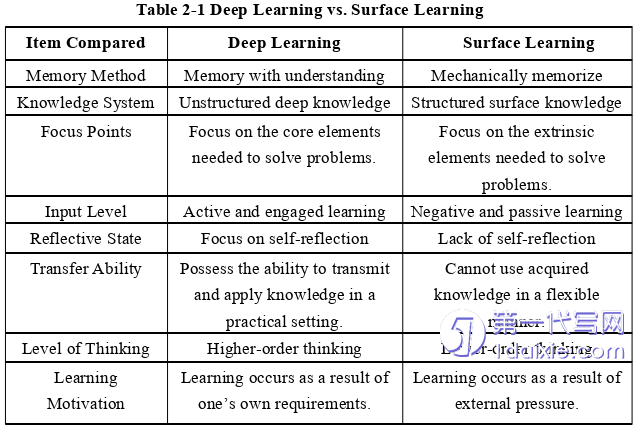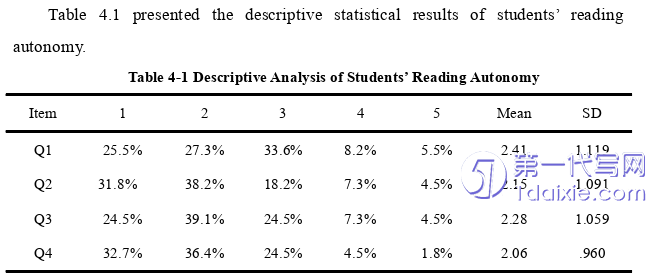本文是一篇英语论文,本研究旨在从深度学习的角度探讨阅读教学模式对提高乌鲁木齐市第四中学高二学生英语阅读能力的影响。实验前,采用问卷调查法对学生在英语阅读课中深度学习的现状进行了评估。然后,通过测试和对学生阅读准确性的测试,研究了这种阅读教学模式对学生阅读成绩和阅读理解能力的影响,包括主要思想、详细理解、干扰判断和词义猜测。
Chapter One Introduction
1.1 Background of the Study
The focus of teaching and learning activities in the twenty-first century learningsociety has shifted from imparting students’intrinsic knowledge to using tools toenable students to actively acquire information from the ocean of information,gainunderstanding and build a learning society.They can also solve practical problems inreal-world environments by utilizing personalized knowledge systems and effectivetransfer.In addition,the ubiquity of the Internet has made it possible to reconstructknowledge faster and faster and to disseminate it more and more easily.In such an era,learners are required not only to learn deeply and apply knowledge creatively torebuild the objective world,but also to know how to learn and learn for life.It iscritical for students to develop their skills and learning abilities in general highschools.And classroom instruction aimed at deep learning helps develop senior highschool students’learning skills.Therefore,the in-depth learning of English readingcourse,which can integrate abundant language knowledge and skill training.It willmeet the requirements of the development of the times.Not only may deep learninghelp students develop a broad range of language application skills,but it may alsoimprove students’learning approaches,foster the development of students’thinkingquality and improve their problem-solving ability and their self-attainment.
1.2 Purpose of the Study
The magnitude of senior high school English reading is transparent.If it is only asurface level of learning,students can’t comprehend the profound meaning of the text.Therefore,this thesis carries out the relevant research on senior high school Englishreading teaching from the prospects of deep learning.It meant to inquire into thecurrent situation of senior two students’deep learning in English reading class.Moreover,it aims at exploring the effects of the reading teaching model from deeplearning perspective on students’reading achievements and reading comprehensionabilities,specifically speaking,scores of the reading comprehension at the end of theexperimental semester.Finally,it is expected to provide corresponding teachingsuggestions for English reading teaching and guide teachers change their readingteaching methods.

Chapter Two Literature Review
2.1 Deep Learning
2.1.1 Definition of Deep Learning
In the 1970s,Marton and Saljo(1976)first proposed the concept of deeplearning based on a reading experiment.They found it in their experiments withstudents’reading.In the process of learning,students have different levels ofinformation processing,showing surface and deep differences.Surface learning is at alow level of cognition and thinking,which is not easily to transfer.Deep learning is atan advanced level,which involves high-level thinking and can transfer.They point outthat deep learning is a learning process,which the learner understands the learningmaterial and processes and transfers the new knowledge in depth in order to illustratethe author’s ideas and intentions in writing.Australian scholar Biggs(1979)continuedthe research of Marton and Saljo,eventually focusing on the learning process on twolevels:deep and surface.He argues that“deep learning aims at understanding andseeking meaning,and striving to lead students to connect prior knowledge withexisting experience and to receive new knowledge critically.”
According to Entwistle(2005),“deep learning refers to when learners try tounderstand the learning text,they make an association between what they havelearned and what they are about to learn,so that knowledge can migrate and transformeffectively and form their own cognitive structure.”
According to the National Research Council(2012),deep learning is not just alearning curve or learning technique,but a kind of ability.Learners are able to applytheir deep understanding of what they have learned to real-world scenarios.
2.2 English Reading Teaching
2.2.1 Definition of Reading
Many foreign scholars have expounded their own views on reading.Goodman(1967)believes that reading refers to learners’ability to acquire and process importantinformation in the text and information provided by the text,so as to achieve thepurpose of constructing new knowledge.In his eyes,reading is a cognitive process ofreaders.Readers obtain information through reading matters.At the same time,they can deduce the interpretation of the articles they read by combining their ownknowledge of social culture,context and situation,as well as the topic knowledgerelated to the reading materials,so as to construct the language meaning andunderstand the author’s intention.Smith(1978)believes that reading is the reader’sunderstanding of the text information and the active construction of the text.Nuttall(2002)believes that reading is an efficacious synergistic communication processbetween the reader,the author and the text.From the perspective of constructivistlinguistics,Anderson(2004)explains that reading is a process of interaction betweenreaders and text materials and the realization of meaning.
There are also many domestic scholars who have written about the definition ofreading.Wang(2012)conceives that reading is an intricate cognitive process.Duringthe process,readers combine their own background knowledge with reading materialsto actively think about the meaning of the article.Wang(2013)mentions that readingis an interactive process through which students can develop the ability to gain andprocess information.The reading process can be regarded as the interaction amongteachers,students and texts.Pan(2014)thinks reading is a complicated cognitiveprocess in which learners retrace their knowledge by critical thinking after extractingthe effective information of the text.Chen(2016)believes that one should use his ownlanguage knowledge,cognitive ability and existing knowledge on the topic toorganize the meaning of the text when reading,and even read new insights differentfrom the author’s original meaning.
Chapter Three Research Design.............................29
3.1 Research Questions.........................29
3.2 Research Participants............................29
3.3 Research Instruments.............................31
Chapter Four Results and Discussion........................47
4.1 Current Situation of Deep Learning in English Reading Class................47
4.1.1 Results of Questionnaire on Current Situation of Deep learning inEnglish Reading Class.......................47
4.1.2 Discussion on the Current Situation of Deep Learning in EnglishReading Class......................53
Chapter Five Conclusion......................77
5.1 Major Findings...................................77
5.2 Implications of the Study.....................79
Chapter Four Results and Discussion
4.1 Current Situation of Deep Learning in English Reading Class
4.1.1 Results of Questionnaire on Current Situation of Deep learning in EnglishReading Class
The first questionnaire is distributed before the experiment,mainly to understandthe current situation of deep learning in English reading class.There are 20 items inthe questionnaire.The questionnaire results were examined in the following ways:a)students’autonomy,b)deep processing of knowledge,c)communication andcooperation,d)knowledge application,e)reflection and evaluation.The surveyresults are listed step by step.
4.1.1.1 Results of Students’Reading Autonomy

Chapter Five Conclusion
5.1 Major Findings
The current study sought to investigate the impact of the reading teaching modelfrom deep learning perspective on improving senior two students’English readingability in Urumqi No.4 Senior High School.A questionnaire was used to assess thestudents’current situation of deep learning in English reading class before theexperiment.Then,the impacts of this reading teaching model on students’readingachievements and reading comprehension abilities in terms of main idea,detailedunderstanding,judgement of interference and word meaning guessing wereinvestigated using tests and an examination of students’reading accuracy.Finally,students’perceptions of the reading teaching model from deep learning perspectivewere explored by a questionnaire and a semi-structured interview.The following is asummary of the significant findings:
Firstly,the current situation of senior two students’deep learning in Englishreading class was on a medium level.The results of the present study consisted withthe results of previous studies,such as Liang(2021).It mainly reflected in thefollowing five areas:(1)The vast majority of senior two students lacked interests inreading learning,and their internal motivation for reading learning was insufficient.(2)The deep processing of knowledge tended to be superficial.Students tended to use alower-order cognitive approach of memorization before language symbols.Theirperception of knowledge learning was not deep,and their thinking strength was alsolimited.(3)Cooperation and communication were absent in cooperative learning,which was primarily characterized by each person performing his or her own task.(4)Students did not perform well in the application and analysis of deep learning.Theywere also not good at using different methods to summarize the learning content.(5)In terms of reflection and evaluation,the overall performance of students was notoptimistic.It was reflected in the lack of reflection on their learning process,especially the lack of attention to the strategies they used in reading class.
reference(omitted)
